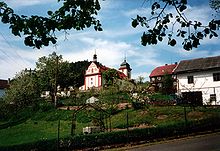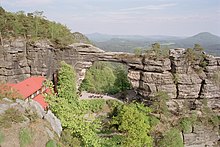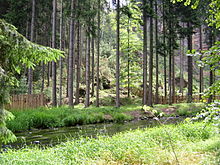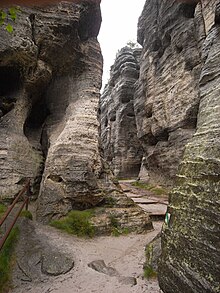Bohemian Switzerland
The Czech Switzerland ( Czech : České Švýcarsko) than the Czech part of the Elbe Sandstone Mountains north of Děčín on both sides of the Elbe . To the east, Bohemian Switzerland merges into the Lusatian Mountains and west into the Ore Mountains . The highest point is the High Snow Mountain ( Děčínský Sněžník ) with 722.8 m. The area has been under landscape protection as ChKO Labské Pískovce since 1972 . The Bohemian Switzerland National Park has existed in the right-hand part of the Elbe since 2000 .
Naming

The term Bohemian Switzerland was based on the name Saxon Switzerland of the German part of the Elbe Sandstone Mountains in the 18th century and is said to go back to the two Swiss artists Adrian Zingg and Anton Graff , who could have felt reminded of their homeland by the landscape.
In the Czech Republic, the terms Děčínská vrchovina (official geomorphological name, German about Tetschener Bergland) and Labské pískovce (Elbe sandstone mountains) also exist for the region .
geology
see Elbe Sandstone Mountains # Geology
Topographic description
In contrast to neighboring Saxon Switzerland, Bohemian Switzerland is not characterized by mountains that tower above the landscape. Exceptions are the mesa High Snow Mountain ( Děčínský Sněžník ) and the basalt tip of Rose Mount ( RŮŽOVSKÝ VRCH ).
The landscape is divided into two parts by the breakthrough valley of the Elbe, which is lined with steep, high rock walls. To the right of the Elbe, the flat, undulating, agricultural landscape - the flatness - extends, which is dominated by the Rosenberg. To the north of it are the rocky areas divided by gorges and the steep rock faces on the south side of the winter mountain ( Prebischtorgebiet ). On the left bank of the Elbe this undulating landscape is densely wooded, in the area of the transition to the Ore Mountains there is the highest mountain in the Elbe Sandstone Mountains, the Hohe Schneeberg. As in the adjoining Ore Mountains , the landscape slopes steeply to the south.
history
In the area of Bohemian Switzerland there are a number of castles to protect the trade routes. Some of the castles were also used as medieval predatory nests. In prehistoric times, this area was sparsely populated by Celtic, Germanic and later Slavic tribes and was only colonized by German-speaking settlers from the 12th century. Until the end of the Second World War it was inhabited by German Bohemia . Since the expulsion of the German population after 1945, this area has been populated almost exclusively by Czechs.
The tourist development did not begin until the 19th century. Romantic artists were inspired by the wild beauty of the rocks, such as the painter Ludwig Richter or the composer Carl Maria von Weber , who set his famous opera Der Freischütz near Rathen .
Rock climbing
Starting in Saxon Switzerland, the rocks in the Bohemian part of the Elbe Sandstone Mountains finally came into view of the mountaineers. With the Beckstein in the Prebischtor area , the first climbing summit in Bohemian Switzerland was opened up in 1888. The most important climbing peaks , all of which were first climbed before the First World War , are: Großer Prebischkegel , Nun , Doggenturm , Empornadel , Wotanskegel and Kastenturm . The development was mainly carried out by German climbers from Dresden and Tetschen-Bodenbach .
After the Second World War , the area was then systematically developed primarily by Czech climbers (e.g. Karel Bělina, Weingartl brothers). From the mid-1960s onwards, German climbers from Dresden were again significantly involved in further development. In the 1970s, the remaining climbing targets in the former restricted border area began to be opened up again.
After the establishment of the Bohemian Switzerland National Park, serious restrictions came into force for mountain sports. At first, as in all Czech national parks, climbing was completely forbidden, later a regulation was made that allowed climbing at certain times of the year.
Attractions

- Prebischtor , the largest natural sandstone rock bridge in Europe
- Edmundsklamm and Stilleklamm , a rocky gorge near Hřensko
- Tyssaer walls , a rock labyrinth
- High Snow Mountain (Děčínský Sněžník), the highest mountain in Bohemian Switzerland with a lookout tower
- Schauenstein rock castle , robbery castle near Vysoká Lipa
- Marienfels , lookout point at Jetřichovice
- Wilhelminenwand , lookout point at Jetřichovice
- Rudolfstein , lookout point at Jetřichovice
- Paulinengrund (Czech: Pavlino Udoli ), a deeply cut , romantic rock valley traversed by the Kreibitzbach (Chribská Kamenice)
- Falkenstein Castle
- Rock chapel in Všemily
- Belvedere near Labská Stráň
- Small Prebischtor
- Balzhütte (Czech: Na Tokani )
- The view of the emperor from the Quaderberg near Děčín
- Lookout tower on Janovsky vrch near Janov u Hřenska
- the well-tended villages with their half-timbered houses
See also
- Děčín barrage - planned Elbe regulation not far from the national park, currently in the approval process
literature
- Natalie Belisova, Zdenek Patzelt, Vaclav Sojka: Popular monuments of Bohemian Switzerland. 2011
- Rostislav Krivanek, Zdenek Patzelt: Saxon-Bohemian Switzerland. A tourist portrait. 2011
- Ferdinand Nahlik: Guide through Bohemian Switzerland. Julius Reinhold publishing house. Bohemian Kamnitz 1864
- Julius Schuldes: Bohemian Switzerland. A guide through the Elbe highlands near Tetschen and Dittersbach . Stopp & Hempel, Tetschen-Bodenbach 1878. Digital copy of the SLUB Dresden via EOD
- Peter Rölke (ed.): Hiking and nature guide Bohemian Switzerland / Ceské Švýcarsko. 23 Hikes Berg- & Naturverlag Rölke Dresden 2011. ISBN 3-934514-07-3
- Saxon Switzerland Tourism Association (Ed.): Churches in Saxon-Bohemian Switzerland. Bad Schandau 1999
- Saxon Switzerland Tourism Association (Ed.): Museums and technical monuments in Saxon-Bohemian Switzerland. Bad Schandau 2000
Web links
- Information about Bohemian Switzerland
- Tourism portal for Bohemian Switzerland
- Bohemian Switzerland Tourist Information
- Official website of the Bohemian Switzerland National Park
- Bohemian and Saxon Switzerland
- Saxon-Bohemian Switzerland
Coordinates: 50 ° 50 ′ N , 14 ° 15 ′ E




